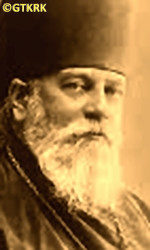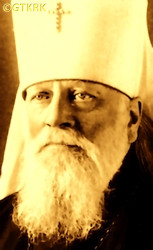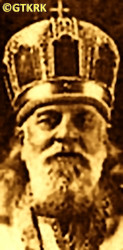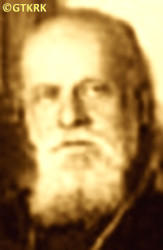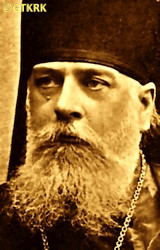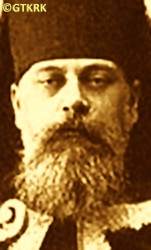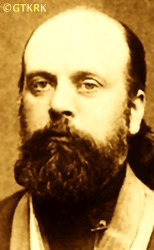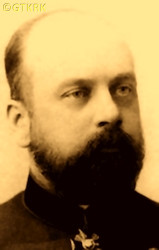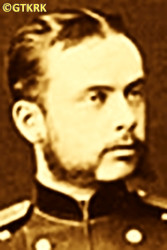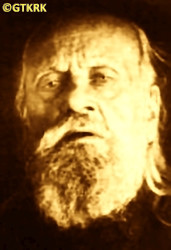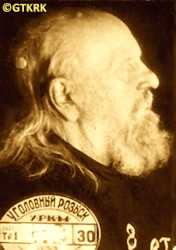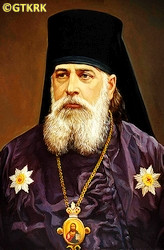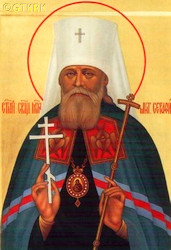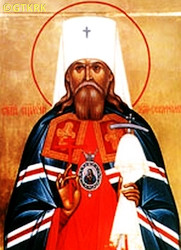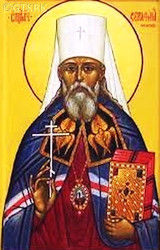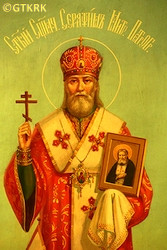Roman Catholic
St Sigismund parish
05-507 Słomczyn
85 Wiślana Str.
Konstancin deanery
Warsaw archdiocese, Poland
full list:
displayClick to display full list

searchClick to search full list by categories
wyświetlKliknij by wyświetlić pełną listę po polsku

szukajKliknij by przeszukać listę wg kategorii po polsku

Martyrology of the clergy — Poland
XX century (1914 – 1989)
personal data
religious status
saint
surname
CZICZAGOW
forename(s)
Leonid
religious forename(s)
Seraphim (pl. Serafin)

canonisation date
23.02.1997

Council of Bishops of the Russian Orthodox Churchmore on
en.wikipedia.org
[access: 2020.09.24]
function
archbishop
creed
Eastern Orthodox Church ORmore on
en.wikipedia.org
[access: 2014.09.21]
diocese / province
Sankt Petersburg ‐ Gdov OR eparchymore on
ru.wikipedia.org
[access: 2023.07.16]
Warsaw‐Vistula OR eparchymore on
pl.wikipedia.org
[access: 2023.07.16]
Tver‐Kashin OR eparchymore on
en.wikipedia.org
[access: 2020.09.24]
Kishinev‐Khotyn OR eparchymore on
en.wikipedia.org
[access: 2023.07.16]
Oryol‐Sevsk OR eparchymore on
drevo-info.ru
[access: 2020.09.24]
Sukhumi OR eparchymore on
en.wikipedia.org
[access: 2023.07.16]
Volodymyr‐Suzdal OR eparchymore on
en.wikipedia.org
[access: 2023.07.16]
honorary titles
Order of St Vladimir (Imperial Russia) 2nd degreemore on
en.wikipedia.org
[access: 2023.04.10]
(1916)
Order of St Anna (Imperial Russia) 1st classmore on
en.wikipedia.org
[access: 2019.10.13]
(1908)
Order of St Vladimir (Imperial Russia) 3rd degreemore on
en.wikipedia.org
[access: 2023.04.10]
(1905)
Order of St Vladimir (Imperial Russia) 4th degreemore on
en.wikipedia.org
[access: 2023.04.10]
(1902)
Order of the Redeemer (Kingdom of Greece) 2nd class Grand Commander with a pectoral crossmore on
en.wikipedia.org
[access: 2023.07.16]
(1897)
Order of St Alexander (Principality of Bulgaria) 2nd class Grand Officer with pectoral cross „Formore on
en.wikipedia.org
[access: 2023.07.16]
(1896)
„To commemorate the Tsar Nicholas II coronation on 26.05.1896” (Imperial Russia) — silver medal
(1896)
Order of St Anna (Imperial Russia) 2nd classmore on
en.wikipedia.org
[access: 2019.10.13]
(1884)
Order of St Alexander (Principality of Bulgaria) 3rd class Commander „For Civil Merit”more on
en.wikipedia.org
[access: 2023.07.16]
(1883)
„Crossing of the Danube Cross” (Kingdom of Romania)more on
en.wikipedia.org
[access: 2023.07.16]
(1883)
„To commemorate the Tsar Alexander III coronation on 17.05.1883” (Imperial Russia) — bronze medal
(1883)
National Order of the Legion of Honour (Fr. Ordre national de la Légion d'honneur) 5th class Chevaliermore on
en.wikipedia.org
[access: 2022.02.04]
(1882)
Order of Saint Stanislav (Russian Empire) 2nd classmore on
en.wikipedia.org
[access: 2019.10.13]
(1881)
Order of St Anna (Imperial Russia) 3rd class with sword and bowmore on
en.wikipedia.org
[access: 2019.10.13]
(1878)
Order of Saint Stanislav (Russian Empire) 3rd class with swords and bowmore on
en.wikipedia.org
[access: 2019.10.13]
(1877)
Order of St Anna (Imperial Russia) 4th class with the inscription „For courage”more on
en.wikipedia.org
[access: 2019.10.13]
(1877)
Order of Prince Danilo I (Montenegro) 4th class Knightmore on
en.wikipedia.org
[access: 2023.07.16]
saber with a dedicatory inscription from the Tsar (Russian Empire)
nationality
Russian
date and place
of death
24.12.1937

Butovotoday: Vidnoye reg., Moscow oblast, Russia
more on
en.wikipedia.org
[access: 2020.07.31]
details of death
After being appointed bishop of the Warsaw–Vistula eparchy, could not take up the position due to the outbreak of the Polish–Russian war of 1919‐1921.
After the Treaty of Riga on 18.03.1921, ending the war, accused of „anti–government activities”, of „intention to create and coordinate abroad Russia, in the event of a planned trip to Poland, an organization of overthrown Russian landowners and capitalists conspiring against the Russian working masses — under the banner of the Friends of Jesus group”, and on 24.06.1921 sentenced by the murderous Bolshevik kangaroo court of the criminal Cheka organization, in the absence of the accused, to two years in exile.
Temporarily left at large, however, but was followed by Cheka agents. Finally, on 21.09.1921, arrested again and held in the Taganka prison in Moscow. On 15.02.1922 released, prob. due to poor health.
On 25.05.1922 — by the decision of the criminal GPU — arrested however again and in 05.1922 exiled to the Arkhangelsk region.
In 03.1923 exiled to the Republic of Mari El, in the middle part of Volga river.
Returned to Moscow prob. at the beginning of 1924. For a short time however, for on 16.04.1924 arrested again by the Russians. Jailed in Butyrki prison. Interrogated repeatedly for a month. On 14.07.1924 released, ordered to leave Moscow immediately and retire „for the rest of his life” — to the Resurrection of the Lord monastery, with the miraculous Fiodorkova Icon of the Mother of God, in the city of Shuya, c. 300 km east of Moscow (one of his daughters, a nun, was already there).
Resided in Shuya for 4 years.
During his ministry as bishop of the Sankt Petersburg – Gdov eparchy in the years of 1928‐1933, experienced the communist action of closing and demolishing Orthodox churches. During another such action — „passportisation” — when the condition for obtaining the right to live in the city became the possession of a „passport”, i.e. an identity card, was refused such and had to leave Sankt Petersburg.
Settled in Tykhvin, c. 200 km to the east.
On 30.11.1937, already retired, arrested in the village of Udelnaya near Moscow, where resided, by agents of the genocidal Russian NKVD organization. Already infirm, was carried out of the house where lived, on a stretcher. Transported in a prison van — repainted as an ambulance for concealment — to the Taganka prison in Moscow. There, interrogated on charges of „conducting monarchist and counter–revolutionary activities”. Rejected the charges.
On 07.12.1937, sentenced to death by the Russian genocidal «NKVD Troika» kangaroo court.
Murdered in a mass execution at the riflemen military training ground c. 25 km south of the center of Moscow.
cause of death
mass murder
perpetrators
Russians
sites and events
Great Purge 1937Click to display the description, Moscow (Taganka)Click to display the description, Moscow (Butyrki)Click to display the description, Forced exileClick to display the description, Polish‐Russian war of 1919‐1921Click to display the description
date and place
of birth
21.06.1856

Sankt Petersburgtoday: Saint Petersburg city, Russia
more on
en.wikipedia.org
[access: 2020.07.31]
alt. dates and places
of birth
21.01.1856
parents
CZICZAGOW Michael
🞲 04.04.1819, Sankt Petersburgtoday: Saint Petersburg city, Russia
more on
en.wikipedia.org
[access: 2020.07.31] — 🕆 05.06.1866, Kalugatoday: Kaluga city reg., Kaluga oblast, Russia
more on
en.wikipedia.org
[access: 2020.09.24]

ZWARKOWSKA Mary
🞲 1819, ? — 🕆 29.11.1894, Sankt Petersburgtoday: Saint Petersburg city, Russia
more on
en.wikipedia.org
[access: 2020.07.31]
baptism
20.10.1856

Sankt Petersburgtoday: Saint Petersburg city, Russia
more on
en.wikipedia.org
[access: 2020.07.31]
St Alexander Nevsky OR chapel (in Mikhailovskaya Military Artillery Academy building)
religious vows
14.08.1898 (permanent)
presbyter (holy orders)
ordination
28.02.1893

Moscowtoday: Moscow city, Russia
more on
en.wikipedia.org
[access: 2020.07.31]
Twelve Apostles OR churchmore on
en.wikipedia.org
[access: 2023.07.16]
positions held
10.1933 – 30.11.1937
resident — Udelnayatoday: Ramenskoye reg., Moscow oblast, Russia
more on
en.wikipedia.org
[access: 2023.07.16] — retired (decommissioned); initially settled in Moscow, at the beginning of 1934 moved to the village of Malakhovka, and then to the village of Udelnaya (by the railway station), 7 km from Malakhovka, where lived in two rooms of a house of a Jewish family
10.02.1928 – 14.10.1933
bishop — Sankt Petersburgtoday: Saint Petersburg city, Russia
more on
en.wikipedia.org
[access: 2020.07.31] ⋄ Russian Orthodox Church ⋄ Sankt Petersburg ‐ Gdov OR eparchy — during his ministry, the Bolshevik–Communist authorities carried out a mass closure of the churches of his eparchy; some of them were demolished (for example, in Kronstadt all churches were closed and all clergymen expelled); in 02.1932 almost all monks were arrested and later expelled from monasteries; at some point was forced to leave Saint Petersburg and live in Tykhvin
1921
metropolita — Russian Orthodox Church — dignity conferment
from 17.09.1918
bishop — Russian Orthodox Church ⋄ Warsaw‐Vistula OR eparchy — appointed; did not take the position: initially the departure was blocked by the new Bolshevik authorities (after the coup in 11.1917), then the authorities of the reborn Polish state refused consent; after some time changed their minds (although they refused the usage the existing seat, the St Alexander Nevsky Cathedral, in the center of Warsaw, a temple demolished by Polish authorities in 1924 as a symbol of the Russian occupation during the partitions); announced his arrival to Poland, but due to the outbreak of the Polish–Russian war of 1919‐1921, had to postpone his departure; resided in the Chernihiv skete (monastric settlement) of the Trinity Lavra of St Sergius in Sergiev Posad, and from 1920 in Moscow, where ministered in various Orthodox churches
20.03.1914 – 1917
bishop — Tvertoday: Tver oblast, Russia
more on
en.wikipedia.org
[access: 2021.10.09] ⋄ Russian Orthodox Church ⋄ Tver‐Kashin OR eparchy — dismissed from office (in the fall of 1917 or at the end of 04.1917) by the congress of the clergy and laity of the Tver eparchy, convened with the consent of the Holy Synod, on the initiative of the Provisional Government (after the fall of the Tsar), due to „excessive severity in managing the eparchy and in contacts with its clergy”; also: awarded with the right to wear a cross on a klobuk (monastic headgear); from 29.02.1916 member of the State Council as a representative from the monastic clergy; member of the Union of Russian People
16.05.1912
archbishop — Russian Orthodox Church — dignity conferment
16.09.1908 – 20.03.1914
bishop — Chișinăutoday: Moldova
more on
en.wikipedia.org
[access: 2022.02.04] ⋄ Russian Orthodox Church ⋄ Kishinev‐Khotyn OR eparchy
06.02.1906 – 16.09.1908
bishop — Oryoltoday: Oryol oblast, Russia
more on
en.wikipedia.org
[access: 2021.09.17] ⋄ Russian Orthodox Church ⋄ Oryol‐Sevsk OR eparchy
20.04.1905 – 06.02.1906
bishop — Sukhumitoday: Abkhazia reg., Georgia
more on
en.wikipedia.org
[access: 2023.07.16] ⋄ Georgian Exarchate, Russian Orthodox Church ⋄ Sukhumi OR eparchy
20.04.1905
Bishop — Moscowtoday: Moscow city, Russia
more on
en.wikipedia.org
[access: 2020.07.31] ⋄ Russian Orthodox Church ⋄ Dormition of the Blessed Virgin Mary OR cathedral church (Uspensky, within Kremlin) — bishop's cheirotonia, i.e. ordination
02.02.1904 – 20.04.1905
rector — Istratoday: Istra city reg., Moscow oblast, Russia
more on
en.wikipedia.org
[access: 2023.07.16] ⋄ Russian Orthodox Church ⋄ Our Lord's Resurrection OR monastery (New Jerusalem)
14.08.1899 – 02.02.1904
rector — Suzdaltoday: Suzdal urban, Suzdal reg., Vladimir oblast, Russia
more on
en.wikipedia.org
[access: 2023.07.16] ⋄ Russian Orthodox Church ⋄ St Euthymius OR monastery — also: dean of all monasteries of the Volodymyr–Suzdal eparchy
14.08.1899
Archimandrite, i.e. superior abbot — Russian Orthodox Church — dignity conferment
14.08.1898 – 14.08.1899
hieromonk — Sergiyev Posadtoday: Sergiyev Posad city reg., Moscow oblast, Russia
more on
en.wikipedia.org
[access: 2023.07.16] ⋄ Russian Orthodox Church ⋄ St Sergius OR monastery (Trinity Lavra)
14.08.1898
hieromonk — Russian Orthodox Church — adoption of the tonsure and perpetual monastic vows
14.02.1896 – 30.04.1898
chaplain — Moscowtoday: Moscow city, Russia
more on
en.wikipedia.org
[access: 2020.07.31] ⋄ artillery detachments of the Moscow garrison, Imperial Russian Army ⋄ St Nicholas the Wonderworker OR church (in Old Vagankov)
1895
widower — four children
1893 – 1896
chaplain — Sankt Petersburgtoday: Saint Petersburg city, Russia
more on
en.wikipedia.org
[access: 2020.07.31] ⋄ Imperial Russian Army ⋄ St Alexander Nevsky OR chapel (in Mikhailovskaya Military Artillery Academy building) — awarded with the right to wear nabedrennik and skufia, special liturgical vestments' parts
28.02.1893
presbiter (Eng. priest, i.e. iereus) — Moscowtoday: Moscow city, Russia
more on
en.wikipedia.org
[access: 2020.07.31] ⋄ Russian Orthodox Church ⋄ Twelve Apostles OR church — priesthood cheirotonia, i.e. ordination, on 26.02.1893 preceded by deacon cheirotonia
1891 – 1893
headman — Sankt Petersburgtoday: Saint Petersburg city, Russia
more on
en.wikipedia.org
[access: 2020.07.31] ⋄ Transfiguration of the Lord OR cathedral church — also: ktetor (founder) of the All–Artillery St Sergius cathedrail in Saint Petersburg; at the same time, privately studied theology and philosophy during his stays in the village of Klementsyevo near Moscow, where as a former soldier–artilleryman was a trustee of the Introduction to the Church of the Mother of God church, located in the center of the artillery training ground of the Moscow district
1875 – 1890
soldier — artillery officer, from 1875 second lieutenant in the 7th horse artillery brigade; then the 5th Horse Artillery Brigade and seconded to the 1st Guards Battery of the Cavalry Artillery Brigade; participant in the Russo–Turkish War of 1877‐1878, i.a. in a series of battles near Plevna (20.07‐10.12.1877), including the Battle of Gorni Dubnyk, in a mountainous area, when on 24.10.1877 the Russian troops captured the fortress of that name, and on 28.10.1887 the fortress of Thelish, and closed the encirclement of Plevna, and the battles of Philipopolis (Plovdiv) 15‐17.01.1878, when the Russian army defeated the army of Suleiman Pasha;); in 1881 a staff captain, sent to France to observe the maneuvers of the French army, particularly artillery; then a participant in arming forts on the western border of Russia and equipping the Bulgarian army; 15.04.1890 retired, in 1891 colonel
author of many works and studies, e.g. „French Artillery in 1882”, Moscow 1883; „The Church of Our Venerable and God–bearing Father Sergius, hegumen of Radonezh, miracle worker”, Moscow 1884; „Archive of Admiral P.V. Chichagov”, Sankt Petersburg 1885; „Paul Vasilyevich Chichagov and his Notes”, Moscow 1886; „The Bravery of Russian Soldiers (Description of Individual Feats 1877‐1878)”, Sankt Petersburg 1891; „Stay of Emperor Alexander II in the Danube Army 1877‐1878”, Sankt Petersburg 1885; „What is the basis of any science”, Moscow 1890; „Medical Conversations of L. M. Chichagov”, Moscow 1892‐1895; „Chronicle of the Serafimo–Diveevsky Monastery”, Moscow 1896; „Word on Good Friday. On Mercy”, Moscow 1896; „Our Lady of Smolensk Zosim's Hermitage”, Moscow 1899; „The Life of St Seraphim, miracle workers from Sarov”, Sankt Petersburg 1903; „The Life of Euthymius Suzdalsky”, Sankt Petersburg 1904; „On the activities of parish councils in the Oryol eparchy”, Oryol 1908; also: author of musical works, i.a. „Music Diary (38 pieces for organ, harmony and piano)”, 1905‐1912; „Spiritual and Musical Compositions”, 1913‐1916; „Cherubin's Hymn No. 2 for mixed choir”; and author of the icons: „Savior in a white tunic” and „The Monk of Seraphim praying on a stone”, St Elijah Orthodox Church in Moscow
sites and events
descriptions
Great Purge 1937: „Great Terror” (also «Great Purge», also called „Yezhovshchyna” after the name of the then head of the NKVD) — a Russian state action of political terror, planned and directed against millions of innocent victims — national minorities, wealthier peasants (kulaks), people considered opponents political, army officers, the greatest intensity of which took place from 09.1936 to 08.1938. It reached its peak starting in the summer of 1937, when Art. 58‐14 of the Penal Code about „counter‐revolutionary sabotage” was passed , which became the basis for the „legalization” of murders, and on 02.07.1937 when the highest authorities of Russia, under the leadership of Joseph Stalin, issued a decree on the initiation of action against the kulaks. Next a number of executive orders of the NKVD followed, including No. 00439 of 25.07.1937, starting the liquidation of 25,000‐42,000 Germans living in Russia (mainly the so‐called Volga Germans); No. 00447 of 30.07.1937, beginning the liquidation of „anti‐Russian elements”, and No. 00485[2] of 11.08.1937, ordering the murder of 139,835 people of Polish nationality (the latter was the largest operation of this type — encompassed 12.5% of all those murdered during the «Great Purge», while Poles constituted 0.4% of the population). In the summer of 1937 Polish Catholic priests held in Solovetsky Islands, Anzer Island and ITL BelbaltLag were locked in prison cells (some in Sankt Petersburg). Next in a few kangaroo, murderous Russian trials (on 09.10.1937, 25.11.1937, among others) run by so‐called «NKVD Troika» all were sentenced to death. They were subsequently executed by a single shot to the back of the head. The murders took place either in Sankt Petersburg prison or directly in places of mass murder, e.g. Sandarmokh or Levashov Wilderness, where their bodies were dumped into the ditches. Other priests were arrested in the places they still ministered in and next murdered in local NKVD headquarters (e.g. in Minsk in Belarus), after equally genocidal trials run by aforementioned «NKVD Troika» kangaroo courts.
Moscow (Taganka): Rus. Таганская тюрьма (Eng. Taganka prison), Russian criminal regional prison in Moscow built in 1804. Both in Tsarist Russia (Russian Empire) and during communist rule used as a political prison. During the so‐called Great Purge of 1937‐1938, many foreign nationals were detained there. In 1940, there were 4,120 prisoners held. Closed on 05.07.1960 and razed to the ground. (more on: en.wikipedia.orgClick to attempt to display webpage
[access: 2023.07.16])
Moscow (Butyrki): Harsh transit and interrogation prison in Moscow — for political prisoners — where Russians held and murdered thousands of Poles. Founded prob. in XVII century. In XIX century many Polish insurgents (Polish uprisings of 1831 and 1863) were held there. During Communist regime a place of internment for political prisoners prior to a transfer to Russian slave labour complex Gulag. During the Great Purge c. 20,000 inmates were held there at any time (c. 170 in every cell). Thousands were murdered. (more on: en.wikipedia.orgClick to attempt to display webpage
[access: 2020.05.01])
Forced exile: One of the standard Russian forms of repression. The prisoners were usually taken to a small village in the middle of nowhere — somewhere in Siberia, in far north or far east — dropped out of the train carriage or a cart, left out without means of subsistence or place to live. (more on: en.wikipedia.orgClick to attempt to display webpage
[access: 2014.12.20])
Polish‐Russian war of 1919‐1921: War for independence of Poland and its borders. Poland regained independence in 1918 but had to fight for its borders with former imperial powers, in particular Russia. Russia planned to incite Bolshevik‐like revolutions in the Western Europe and thus invaded Poland. Russian invaders were defeated in 08.1920 in a battle called Warsaw battle („Vistula river miracle”, one of the 10 most important battles in history, according to some historians). Thanks to this victory Poland recaptured part of the lands lost during partitions of Poland in XVIII century, and Europe was saved from the genocidal Communism. (more on: en.wikipedia.orgClick to attempt to display webpage
[access: 2014.12.20])
sources
personal:
pl.wikipedia.orgClick to attempt to display webpage
[access: 2023.07.16], ru.wikipedia.orgClick to attempt to display webpage
[access: 2023.07.16], drevo-info.ruClick to attempt to display webpage
[access: 2023.07.16]
bibliographical:
„Hierachy, clergy and employees of the Orthodox Church in the 19th‐21st centuries within the borders of the Second Polish Republic and post–war Poland”, Fr Gregory Sosna, M. Antonine Troc-Sosna, Warsaw–Bielsk Podlaski 2017
original images:
visz.nlr.ruClick to attempt to display webpage
[access: 2023.07.16], drevo-info.ruClick to attempt to display webpage
[access: 2023.07.16], commons.wikimedia.orgClick to attempt to display webpage
[access: 2023.07.16], foma.ruClick to attempt to display webpage
[access: 2023.07.16], drevo-info.ruClick to attempt to display webpage
[access: 2023.07.16], commons.wikimedia.orgClick to attempt to display webpage
[access: 2023.07.16], www.pravmir.ruClick to attempt to display webpage
[access: 2023.07.16], www.pravmir.ruClick to attempt to display webpage
[access: 2023.07.16], commons.wikimedia.orgClick to attempt to display webpage
[access: 2023.07.16], drevo-info.ruClick to attempt to display webpage
[access: 2023.07.16], commons.wikimedia.orgClick to attempt to display webpage
[access: 2023.07.16], orel-eparhia.ruClick to attempt to display webpage
[access: 2023.07.16], drevo-info.ruClick to attempt to display webpage
[access: 2023.07.16], diomedes2.livejournal.comClick to attempt to display webpage
[access: 2023.07.16], azbyka.ruClick to attempt to display webpage
[access: 2023.07.16], diomedes2.livejournal.comClick to attempt to display webpage
[access: 2023.07.16], diveevo-monastyr.ruClick to attempt to display webpage
[access: 2023.07.16]
LETTER to CUSTODIAN/ADMINISTRATOR
If you have an Email client on your communicator/computer — such as Mozilla Thunderbird, Windows Mail or Microsoft Outlook, described at WikipediaPatrz:
en.wikipedia.org, among others — try the link below, please:
LETTER to CUSTODIAN/ADMINISTRATORClick and try to call your own Email client
If however you do not run such a client or the above link is not active please send an email to the Custodian/Administrator using your account — in your customary email/correspondence engine — at the following address:

giving the following as the subject:
MARTYROLOGY: CZICZAGOW
To return to the biography press below:
 Click to return to biography
Click to return to biography








